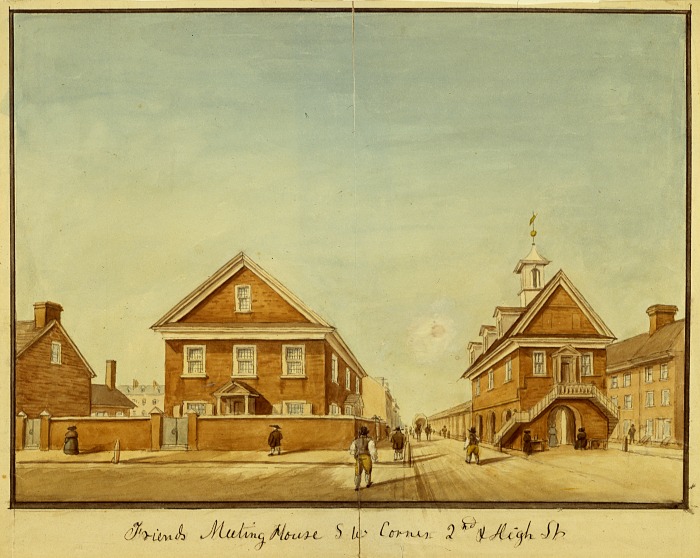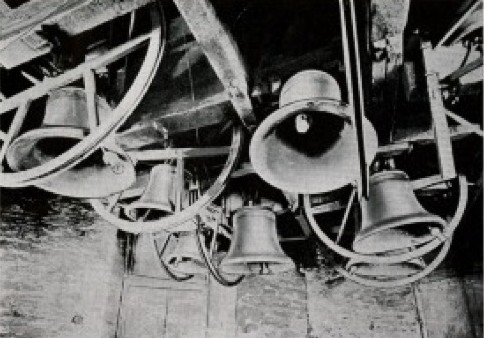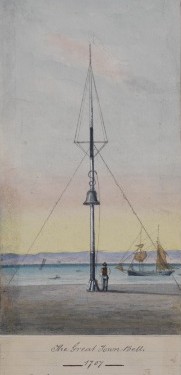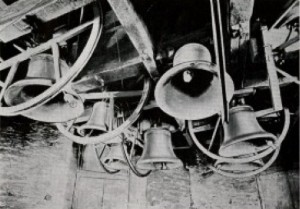Sounds of the City: The Colonial Era
Essay
Soon after its founding, Philadelphia quickly crossed the threshold from a mere rural agglomeration into a true city, complete with an urban soundscape. In contrast to the countryside, where large distances and tree lines weakened the intensity of sound traveling between farms, within the city neighbors had no choice but to hear the diverse noises that resulted from both private and public endeavors. Despite William Penn’s vision of a city spread between the Delaware River and the Schuylkill, Philadelphia remained densely concentrated along the Delaware throughout the eighteenth century. Sounds from the private sphere and public life blended and intruded without hindrance: women’s batting staffs, street criers, and bells sounded loudly throughout the city’s domestic, commercial, and religious life.
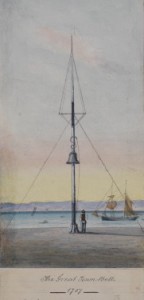
At the intersection of Second and Market Streets, a center of early Philadelphia’s civic life, the soundscape quickly began to diverge from that of the countryside. As early as 1682 it was the site of a simple cage for the city’s criminal offenders with no sound insulation whatsoever, and a later prison built in the middle of Market Street was labeled a nuisance by the city’s Grand Jury in 1702. The area also resounded with the bleating of sheep, which were pastured on the common area by the town butcher. Plenty of human noise followed as well when Philadelphia’s market was moved from Front Street to Second Street. A bell rang out to signify the opening of the market, which quickly gave Market Street (originally called High Street) its name. Bells were a common means of sonic communication in the colonial city, present in churches, clocks, schools, and atop the Court House built at Second and Market in 1707. After 1751, the soundscape also included the State House bell, later called the Liberty Bell, which called members of the Pennsylvania Assembly to work.
The Court House steps at Second and Market served as the site of the some of the earliest sermons in the city by the Reverend George Whitefield (1714-70), whose loud voice drew crowds outdoors. Preaching in London in the 1730s, Whitefield had drawn outdoor audiences estimated at the time from 20,000 to 80,000 listeners. When Whitefield arrived in Philadelphia in 1739, a skeptical Benjamin Franklin (1706-90) decided to test the accounts by experiment: while Whitefield preached from the Court House steps, Franklin walked east on Market Street and reported that Whitefield’s voice remained intelligible until he arrived at Front Street. Using this distance, Franklin calculated that Whitefield’s voice could have been heard by more than 30,000 listeners.
Sounds of Music and Singing
Instrumental music and singing added to the sounds of the city. Religious leaders discouraged secular or instrumental music, preferring only devotional hymns during church services, and in 1740 only three churches in the city possessed an organ. Gradually, as the influence of Whitefield’s revivals waned, instrumental music became more popular. By 1774 every worship service in Philadelphia used an organ except the silent worship of the Society of Friends. Public houses were often centers of popular music, and David Lockwood’s tavern even had a “Musical Clock,” which played “Sonatas, Concertos, Marches, Minuets, Jiggs, and Scots Airs.”
In contrast to the riotous atmosphere at many taverns, the upper echelons of Philadelphia society preferred the more subdued conversation at the city’s growing number of coffee houses, including the famous London Coffee House at the corner of Front and Market Street, which opened in 1754. It began as a place for civil conversations and business transactions between merchants and traders, but this led to the Coffee House’s use as an all-purpose auction house for horses, carriages, and even slaves. This louder commercial soundscape eventually gave way to the crackles of bonfires and shouts of revolutionary mobs: as the conflict with Britain worsened in the 1760s, the street in front of the Coffee House became the site of protests against the Stamp Act and later the burning in effigy of British officials.
Carriages and wagons traveling from the countryside to the wharves along the river, as well as the whip cracks of their drivers, continually generated noise. In the first half of the eighteenth century, streets were not often paved, and what pavement there was consisted of what archaeologists call pebblestone, similar to gravel. Dirt and gravel roads provided less rigid surfaces than a hard cobblestone pavement, reducing the noise from cartwheels and horses’ hooves while producing a slight hiss from the small particles of stone sticking to wheels (as in the audio example). But as the city developed more in the second half of the century, streets became more uniformly and solidly paved and wheels were more likely to be lined with iron, both of which increased the radiated noise throughout the city. John Fanning Watson’s Annals of Philadelphia in the Olden Time (1830) included several anecdotes of citizens hearing voices or artillery over great distances, and older residents told him that it was easier to hear distant sounds when the city had fewer carriages and unpaved streets. These sounds, along those of the herds of livestock occasionally moving through the city, ensured that the colonial city’s soundscape was not entirely divorced from the sounds of the countryside.
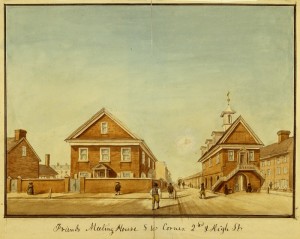
Riverfront Soundscape
While the carriages heading to the wharves generated noise throughout Philadelphia, the Delaware riverfront provided another diverse soundscape on the edge of the growing city. Taverns and grog shops in riverfront caves contributed to the lower-class reputation of the waterfront through the frivolity, songs, and brawls that went along with their wares. The wharves further infused the soundscape with clanking anchors and chains, the groaning of masts and riggings, the speech of sailors and merchants, and the loading and unloading of carriages, wagons, and ships.
Nights in the city were quieter by and large, marked by the occasional “crying of the hour” by the night watchman. Occasionally, however, disturbances broke out when taverns brawls erupted into the streets. In the years leading to the American Revolution, British soldiers in the city may have affected transatlantic relations through their nighttime noisemaking: in 1769, a young Englishman named Alexander Macraby recorded that he, along with several officers and a band, routinely paraded through the streets at midnight and played under the windows of young women, “which,” he added, “they esteem a high compliment.” Occasionally their celebrations passed into the countryside, such as when Macraby wrote that they took seven sleighs with fiddlers on horseback “to a public house a few miles from town, where we danced, sung and romped and eat and drank, and kicked away care from morning till night.”
The growing noise of the city led the citizens of Philadelphia to take action. As early as 1732, the city drew up a noise ordinance restricting gatherings and noise-making on Sundays, possibly for the peace of the Friends’ worship services. Maintaining silence within the Friends’ meeting house amid the street noise of children, dogs, and carriages at Second and Market Streets remained challenging as the city grew, leading the Friends to move to their new meeting house on Arch Street in 1804. Some wealthy citizens, meanwhile, chose to escape to the suburbs. As early as 1711, Robert Fairman mentioned in a letter the benefits of a plantation “out of the noise of Philadelphia, but in site of it.” In 1770, the principal of a private academy north of Philadelphia likewise advertised his college as being “free from the noise of the city.” And in a letter to his brother in Rhode Island in 1774, Doctor Solomon Drowne wrote from Philadelphia, “I almost envy you your pleasant situation on Mendon’s pleasant Hill, remote from Noise & Confusion. Here the thundering of Coaches, Chariots, Chaises, Waggons, Drays, and the whole Fraternity of Noise almost continually assails our Ears.”
While some scholars have argued that colonial Philadelphia was even louder than a modern urban environment, the crucial difference is not the overall loudness over time but the different textures of the soundscapes. Modern city noise is characterized by relatively continuous background noise from engines, generators, and ventilation systems. In contrast, eighteenth-century Philadelphians heard many short, impulsive sounds rising over a very quiet pre-electric background. Only at the busiest times did the colonial city have enough individual sources of noise to blend into anything continuous enough to be perceived as background noise. The rest of the time these sharp sounds would ring out into the foreground of public attention, one of the many growing pains for the young city.
Braxton Boren is a PhD Candidate in the Music and Audio Research Lab and New York University. He specializes in applying physics and technology to research questions in the arts and humanities. (Author information current at time of publication.)
Copyright 2013, Rutgers University.
